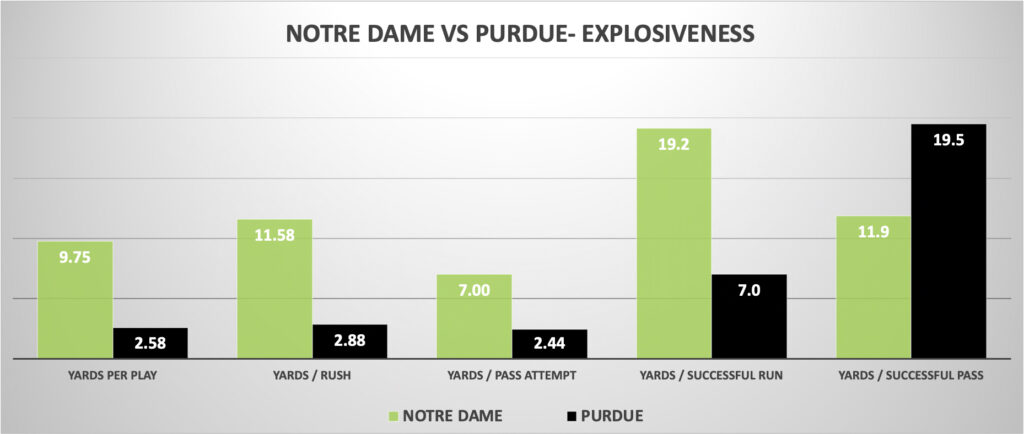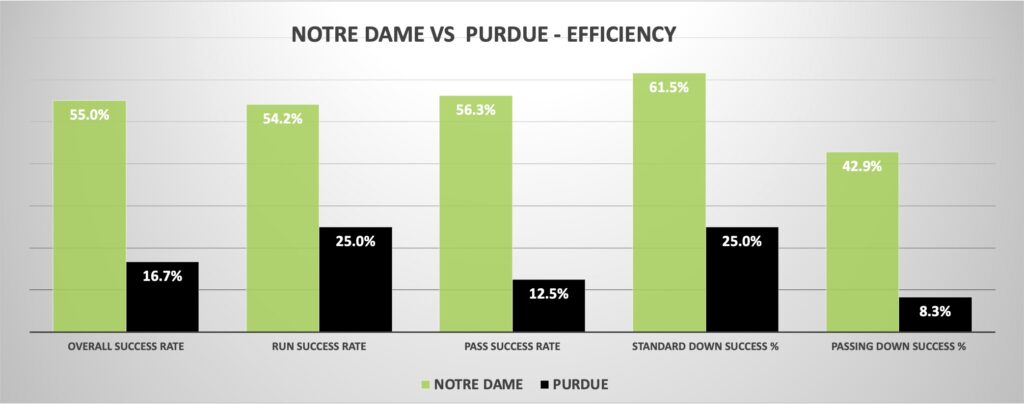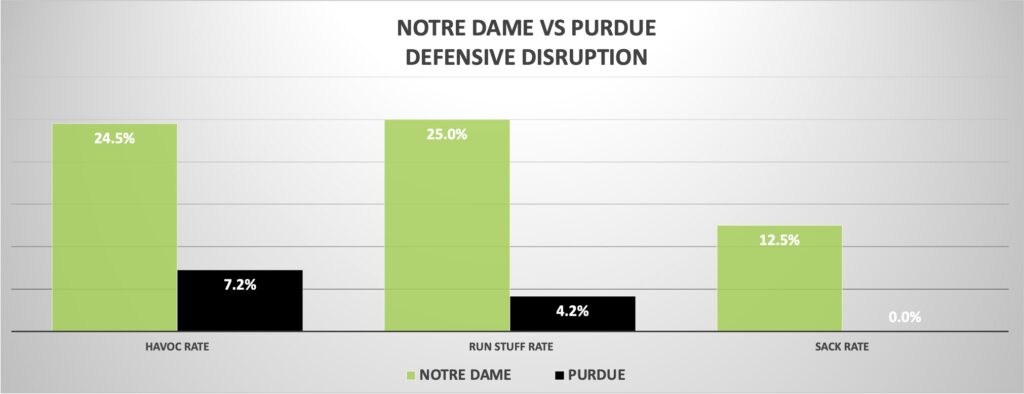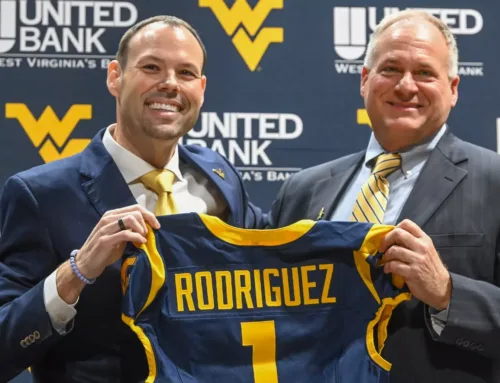Notre Dame bounced back with a vengeance in West Lafayette, laying waste to a Purdue team that was completely overwhelmed on both sides of the ball. The explosive rushing attack once again fueled the Irish offense and was complemented by a more efficient passing game. Passing explosiveness, still a question mark.
The defense was dominant as well, holding Purdue to 2.58 yards per play before garbage time and a minuscule 16.7% success rate. The Boilers average 3rd down distance was 10.3 yards to gain, so Hudson Card and company in the aggregate would have been better off tossing the ball into the stands on 1st and 2nd down instead of moving ever-so-slightly backwards with negative plays and penalties.

This is what the ideal ND rushing attack looks like in 2024

Last week the radar chart showed that the Irish offense really only had one pure strength – creating long rushing plays. Against Purdue, that turned out to be more than enough with three rushing touchdowns of 34+ yards in the first half alone to put the game away early.
Stable Talk🐎
2024 ND RB Room as a whole among 134 FBS programs
– 7.5 YPC (6th)
– 5 breakaway TDs (1st)
– 5.8 yds after contact per att (3rd)
– 0.39 broken tackles per att (6th) pic.twitter.com/YqaXlGvIUb— Deland McCullough (@coachdmc) September 16, 2024
Jeremiyah Love and Jadarian Price have been spectacular in every game so far, and the advanced stats definitely support it. Even more than the opener at A&M, this game also showed why Riley Leonard’s rushing stats from Duke were so absurd. It may not look as smooth as Love and Price, but he’s also one of the best QBs in college football at creating missed tackles and yards after contact.
RBs with 20+ carries yards after contact per rush (via PFF):
Jadarian Price 7.4 (1st)
Jeremiyah Love 5.6 (11th)PFF elusiveness rating (measures success + impact regardless of blocking):
Love 3rd
Price 7th— Jamie Uyeyama (@jamieuyeyama) September 15, 2024
A week after a 44% early down rush rate, the Irish ran the ball on 60% of early downs in West Lafayette. This was a huge bounce-back effort from Mike Denbrock, who also deployed far more motion and play-action in this game than we had seen. With Ryan Walters’ deep obsession with man coverage this may have been one of the most predictable defenses to scheme against this year, but it’s encouraging to see Denbrock breaking out some more exotic screens, end-arounds, and QB run plays that inexplicably disappeared late in the home opener.
Notre Dame offense easy button usage
Play action rate
First 2 games: 9%
vs. Purdue: 28%Motion rate
First 2 games: 49%
vs. Purdue: 67%Snap motion rate
First 2 games: 15%
vs. Purdue: 29%— Notre Dame Football Stats & Analytics (@ND_FB_Analytics) September 17, 2024
The offensive line also deserves a lot of love here, especially with the losses of Billy Schrauth and Ashton Craig in this game. This was a strong performance with just one run stuff allowed on 24 first half rushes. The ability to create more efficiency in the run game to add to the explosiveness is critical to sustaining drives and avoiding too many long passing downs.
While things were far more comfortable in this game, on 3rd and 5+ conversions weren’t easy. In fact, in the six 3rd and long situations against Purdue (pre-garbage time) the Irish had four runs – three scrambles by Leonard and the Aneyas Williams first down conversion that was likely setting up a 4th down attempt if it failed. The two passes were both successful third down conversions to Mitchell Evans, who had a lot of work to do after the catch on both plays to keep drives going.
The passing game panic-meter is still in the same place

We’ve seen Notre Dame’s offense successfully execute “Plan A” twice in the three games this season. Run the ball well enough with the star running backs and Leonard, creating explosive plays, while passing the ball efficiently enough to keep defenses off balance and keep drives alive. In the first half against Purdue the Irish were more efficient passing the ball than rushing it – it just didn’t feel that way without many big plays.
The problem is what happens when Plan B needs to be activated and Notre Dame may struggle for an effective counter. In last week’s game that shall not be named, Leonard’s legs disappeared from the equation in the second half. Against a zone-heavy team, the short-medium passing efficiency evaporated and the Irish couldn’t find open receivers downfield to overcome it. The explosive potential of the run game is incredibly important, but having six of nine touchdowns so far this year come from outside the red zone is indicative of the struggles to put long, sustained drives together. What happens when the Irish better quality bend but don’t break defenses?
Two things that are both true – this offense needs Riley Leonard’s legs and it also needs more from the passing game than what we’ve seen through 25% of the regular season. It’s worth noting that the passing success against Purdue with Leonard (56.3%) was significantly higher than Angeli (33.3%), with pretty comparable yards per pass attempt (7.0 for Leonard, 6.9 for Angeli). They achieved those numbers with very different formulas, as Angeli hit some bigger throws but was less efficient and took three sacks in his 12 dropbacks (a tendency worth monitoring).
We also didn’t learn much about the receiver situation in this game. With the blowout leading to a deep rotation, KK Smith led the receivers in snaps (43) followed by Beaux Collins (28) and Deion Colzie (26). Collins continued to be a favorite target early. No targets for Jaden Greathouse and just 12 snaps is a little curious.
Al Golden puts another opposing QB in a blender

The Irish defense finally was able to turn up the disruption against Hudson Card and the Purdue air raid, posting a season high havoc and run stuff rate. Al Golden’s constant pressure drew penalties and created negative plays that consistently put the Boilermakers behind the chains (50% of plays before garbage time were passing downs, where the Boilermakers had one successful play on 12 attempts).

Turnover luck held very close to expected amounts in this game, although Card and the Boilers put the ball in danger far more often (including a missing Christian Gray pick-six, possibly his second in three games). Purdue had a 1st percentile expected points aadded (EPA) per play overall, and Card’s total EPA was roughly -18 points. The average Purdue drive before garbage time was 3.4 plays and 8.9 yards.




